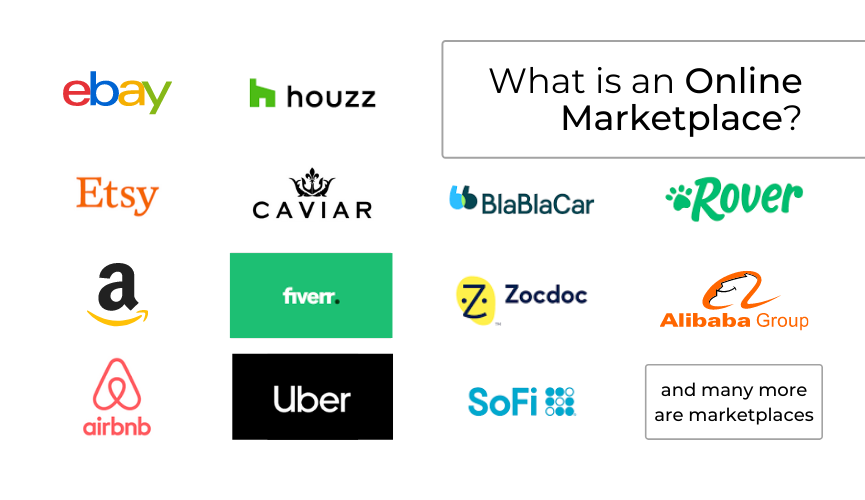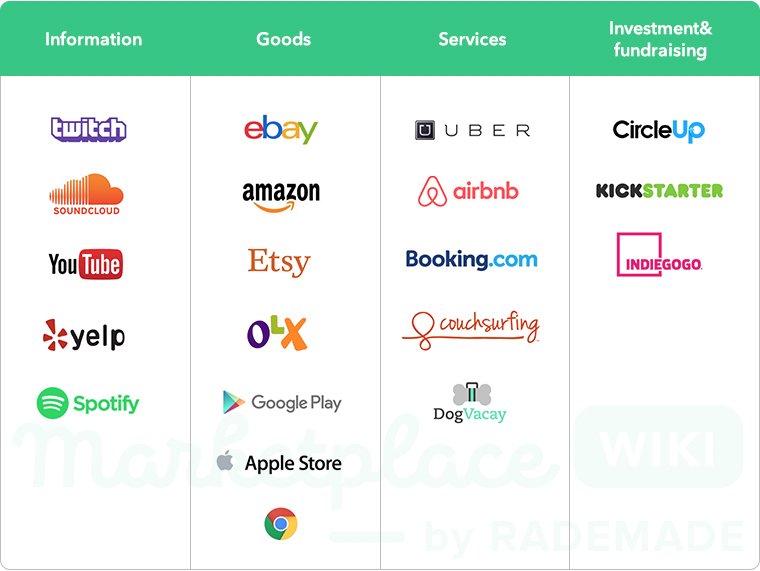Although the idea of a digital marketplace is fairly universal, there are actually a lot of different ways to go about creating your own.
Every choice you make as you work to create your own digital marketplace must be guided by the demands of your target market, which are what smart firms construct their marketplaces around.
What are digital marketplaces?
Digital marketplaces are online venues that bring together buyers and vendors. They connect customers looking for a service or product with businesses that sell or offer those goods or services.
What are some examples of digital marketplaces?
Let’s examine the various marketplace kinds and the markets they serve in light of the tremendous e-commerce growth anticipated over the coming ten years.
With possibilities for expansion and a focus on servicing the needs of customers, the marketplace industry is big and complex.
Related Reading: Contextual Commerce – The Future in Digital-Centric Ecommerce
Business-to-consumer (B2C) marketplaces
One of the most crowded categories, with a huge number of competitors, including international behemoths like Amazon and regional leaders like TMALL and jd.com in China and Mercado Livre in Brazil and Latin America.
Niche B2C marketplaces that are concentrated on particular industries, such as electronics, fashion, and home renovation, can then be added to the mix. There is fierce competition for you.
Business-to-business (B2B) marketplaces
B2B marketplaces have a growing potential in terms of money alone. Examples to note are Amazon Business and Alibaba. B2B marketplaces are more narrowly specialized and vertically oriented.
Peer-to-peer (P2P) or consumer-to-consumer (C2C) marketplaces
PinDuoDuo is the largest and most notable example of this kind of marketplace. This approach has quickly amassed a 4% market share of global e-commerce and is ready to spread beyond China to include the rest of the world.
Service-to-consumer (S2C) marketplaces
Despite being a made-up term, this is a growing category with lots of local instances.
Consider TaskRabbit and HomeAdvisor in the United States, UrbanClap in India, hipages in Australia, and similar services. The gig economy is strong!

Related Reading: Shoppable Media – What is it and how it leverages social commerce
What are the benefits of a digital marketplace?
Despite being a made-up phrase, this category is expanding and has many local examples.
Take into account businesses like TaskRabbit and HomeAdvisor in the US, UrbanClap in India, hipages in Australia, and others. There is a robust gig economy!
Similar to other marketplaces, Amazon has made it simple for sellers to begin selling on their platform.
To entice vendors to use its platform, Amazon offers a step-by-step manual. Key tactics for luring sellers include quick onboarding, product uploads, price, promotions, and proof-of-concept trial balloons or propel-growth techniques.
The following online marketplace benefits will provide more clarity.
1. Access to a ready audience of clients
Marketplaces that offer a one-stop shopping experience to a sizable, devoted consumer base are what sellers want.
This implies that manufacturers and sellers can establish and expand their businesses on marketplaces before diversifying into other channels.
Consider Anker Innovations, which got its start on Amazon Marketplace and now gets more than 90% of its online sales from the retailer.
2. Logistics, payment, and fulfillment
When the marketplace operator controls operational complexity, sellers can benefit greatly and save a tonne of money.
The marketplaces themselves have perfected the chores of warehousing, shipping, and payment collecting, so sellers are freed from those duties.
3. Special occasions
Operators of marketplaces are experts at creating opportunities throughout the year.
For instance, Singles Day, an unofficial substitute for Valentine’s Day in China, generates $74.1 billion annually and is expanding at a rate of about 50%. Prime Day on Amazon, meanwhile, generates $6 billion globally and is expanding at a 60% annual rate.
4. Innovation
Marketplaces are the leading e-commerce innovators because they are constantly coming up with new ideas.
For instance, voice-enabled search became an enormous e-commerce prospect after the introduction of smart speakers.

5. Special discounts
With indirect offerings like free shipping, video and audio streaming, free books, and more, marketplaces also draw customers and keep them on their platforms.
A yearly membership is offered by some markets. These elusive advantages draw and guarantee a more captive consumer base.
6. Analytics, personalisation, and marketing
Markets that are profitable provide a variety of marketing and customisation options.
Many employ sophisticated, AI-based technology to hyper-personalize the client experience using a customer data platform. The majority of marketplaces allow for direct communication with their customers.
It is invaluable to be able to employ advanced analytics to analyze the competition and modify pricing, promotions, and offers.
It is essential to use data to drive specific product lines, increase manufacturing, and optimize operations to fulfill demand.
7. After-sale assistance
Marketplaces have a singular focus on the entire consumer experience, even after the sale.
The marketplace operator is in charge of managing this capacity to turn clients into lifelong admirers.
8. Global scope
“Think locally, act internationally,” they say. Businesses in a global economy might have a worldwide reach thanks to markets with a wide geographic scope.
Local markets act as a springboard, but any seller with expansion aspirations will value the chance to service customers globally and increase sales.
Although not all marketplace types offer these benefits equally, they are all crucial factors for every seller.
B2B markets, for instance, face particular difficulties with regard to payment, financing, logistics, and fulfillment requirements that must be catered to differently.
Related Reading: Ecommerce Testing? Whats, Whys and How To Optimize For Sales
Why should you adopt a digital marketplace ecommerce strategy?
You wish to grow your business into the internet space as a merchant who currently sells products from third parties in brick and mortar locations.
As a business owner, you want to broaden your consumer base by adding items from other brands to the range while simultaneously promoting your own name and product lines.
You wish to create a marketplace as a B2B commerce operator with a sizable first-party dealer distributor network in order to have more control over the network, the goods and services provided, and the general customer experience.
You must manage a sizable OEM supplier network as a business operator to ensure quality.
Since commissions are the main source of income for marketplaces, they require this flood of companies. A better product selection, better brands, and more customers all result from more vendors.
Digital markets take years to establish a name, but if a company has the plan, the vision, and the people to run a marketplace and sell products from other companies, the prospects are limitless.
In order to facilitate setup, all SaaS cloud platform providers for e-commerce offer either integrated marketplace administration capabilities or solid agreements with SaaS marketplace platform providers.
What are some latest digital marketplace trends?
Digital marketplaces will split apart more. In order to compete, sellers will become more picky about which platforms they use.
Watch out for consolidation as smaller, local, niche, and disruptive marketplaces are taken over by larger firms at the same time.
In order to draw customers to marketplaces, commissions and value-added services will become the next front in the conflict.
Consumer experiences that are delightful and novel will be increasingly more important in luring clients and customers.
The best selections and experiences from brands will be saved for their direct e-commerce businesses. They might even use marketplaces as networks for affiliate marketing.
Finally, social networking firms may develop into independent market players. Think of LinkedIn as the leading B2B marketplace. (It’s entirely possible!)
Now is the moment to start planning if you want to compete in the markets of the future.
Apply the time you would have spent perusing your preferred B2C marketplace to your company’s marketplace strategy.
After all, the mere fact that you’re browsing Amazon or sites like it says a lot about the continued significance of marketplaces and their expanding potential in the digital age.
Creating value for every customer through digital marketplaces
There is one significant distinction between managing a marketplace and operating a typical digital storefront: in a marketplace, buyers and sellers are your actual consumers. A market only functions if both parties are satisfied.
The easiest kind of marketplace, when it comes to low-hanging fruit, would be an addition to an already-existing digital commerce channel.
This is because in order to attract vendors to your website, they must first list their goods there. They make an effort to do this, and they typically use a Seller portal or an API. They have little incentive to invest the time needed to manage that sales if you are not actively selling their products.
This is not to say you can’t start a marketplace without already having an eCommerce site: it just means that you must engage in very thorough research to make sure there are enough sellers and customers already out there – whose needs are currently unmet – to support a new marketplace.
Making a marketplace that appeals to a specific demographic of customers not only attracts traffic from eager buyers, but it also teaches merchants how to make money in your marketplace.
You can create a marketplace to serve a specific market segment with one-of-a-kind products and services.
No matter how obscure their pastime, Panjo.com provides all kinds of varied enthusiasts with the things they require to support or flaunt it.
You are well-positioned to establish a general market if you have access to a wide range of items and can compete on price, logistics, or other operations. By providing a broad selection of goods or services, one-stop shops like Amazon, eBay, and others carry out this strategy.
No matter which way your market develops, it’s crucial to be able to make your clients’ lives better. Understanding your clients’ needs and what extra they could require to complement their lifestyle and shopping patterns is necessary for this.
You can begin looking at technologies that will meet these needs only after you have a clear understanding of these needs.
Related Reading: Ecommerce Analytics: Leveraging Data To Unlock Online Sales
In closing,
The B2B sector offers the most profitable opportunities, as is true for the majority of the internet commerce industry.
Although there are opportunities in the B2C sector as well—many websites encourage 3P merchants to list their goods—B2B commerce’s size and range of applications make it impossible to ignore.
There are already a lot of markets out there, and there will undoubtedly be more. What person will succeed Etsy? Who will be the following Amazon, or? Time will only tell.
But one thing is certain: marketplaces are here to stay, and when properly tapped into, they can ultimately transform your company. Need help? Let’s talk!






